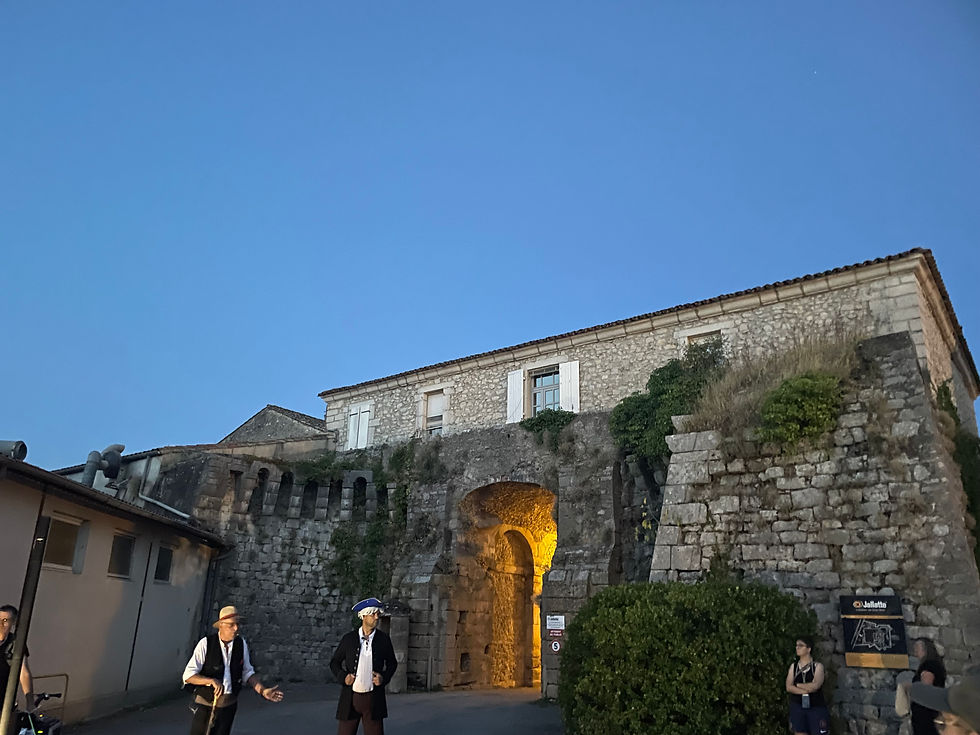The Tower Around the Corner
- JanetJoanouWeiner

- May 21, 2022
- 3 min read
Updated: Jun 4, 2022
One of the most iconic structures in St. Hippolyte is an ancient limestone tower, just across the bridge and around the corner from my home.

I often stop on the Planque bridge and admire the scenery. One direction offers a gorgeous view of the river running below, fast or slow, depending on the season. Up on the left is the Tower of St. Jean, set into one corner of rampart walls built to encircle the town by King Louis XIV in 1687.

On the map below, you can see St. Jean tower on the upper left and the fort on the bottom right. The Château de Planque (where I live and work) is under the word "Ville"! The rampart walls are indicated by the dark line surrounding the town.

Between the rampart walls and the fort the King also constructed, the Huguenot population were virtual prisoners for close to 100 years. While such things are usually put in place to protect people, these were for control. A local man told me that this “marks them” to this day
Above the river and the tower, the cliffs of Le Cengle soar high into the sky. This mountain played an essential part in my historical novel, Though Darkness Descend. Based on actual events, the Huguenots moved to its steep terraces while waiting for an army of dragoon soldiers to arrive. They called themselves Le Camp de l’Eternel, The Lord’s Army. You’ll have to read the book to find out what happens!
Built as a gun tower, St. Jean linked to the ramparts and thus the town by a bridge over the road. In the 17th-18th centuries, there was no access into the tower on the ground level, reducing the danger of attack. The lowest floor was level with the river below.

When I pass by the 80 feet (26 meters) tall tower, I sometimes try to imagine it back in the day, guarded by artillery and numerous dragoons. One of the town's entry points was here. Locals had to sign out and then submit to questioning upon return at these exit and entry "doors." Most of the time, this included verbal and physical harassment. Hard to believe, but true.
One purpose of St. Hippo’s fort was to imprison Huguenots––including children (story to come in my second book.) When the fort’s dungeons reached capacity, authorities sent the overflow prisoners to St Jean––mostly women who refused to renounce their faith. They were incarcerated in the tower's bottom level and often died due to disease, the freezing damp, or by drowning from the rising river. A heart-wrenching story, among many others in the history of the wars of religion.


Today, children play freely OUTSIDE the tower
Back at street level, if we turn left, we enter a road that runs into the town center. On the corner is this impressive stone outcropping with a house perched at the top. The bridge used that ran over the road connected the tower with this structure.

Just past this is an intriguing space carved into the foot of the mountain. In Though Darkness Descends, I called this the old lavoir, a communal basin for laundry––a little hard to see the length of it in this photo.
The steep, brush-covered hill above is the location of a shoot-out between Huguenots and dragoons, at least in Though Darkness Descends!

Today, the St. Jean tower is privately owned by a retired couple. They dreamt of opening the upper levels, including the roof, as a café. How lovely that would have been! Because it is a historic structure, they were unable to make the necessary modifications. So, they live there, and when I pass by, I smile at the potted flowers and plants by the front door on ground level, where there was once no entry. Inside, lights and sounds indicate life.


I’m grateful to live with the constant reminder of a time when freedom was extinguished. Control, oppression, and fighting for fundamental rights were a way of life in this region for over 100 years. It's important to learn from these lessons of history, so that we fully appreciate our liberty and the price paid to obtain it.
La vie est belle!








Love these pictures and the story behind them. Can't wait for the second installment!
🤩